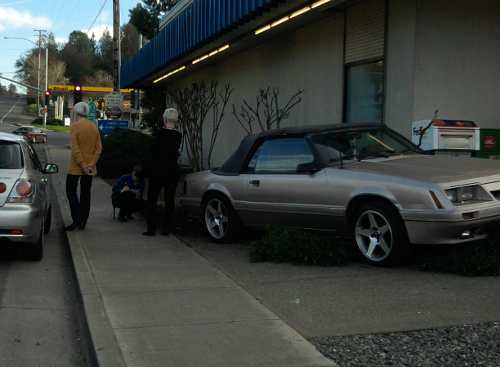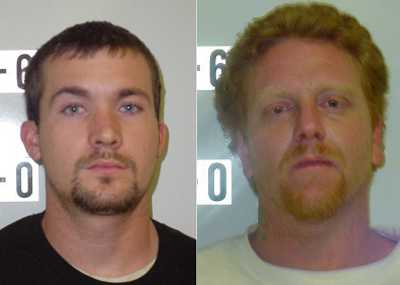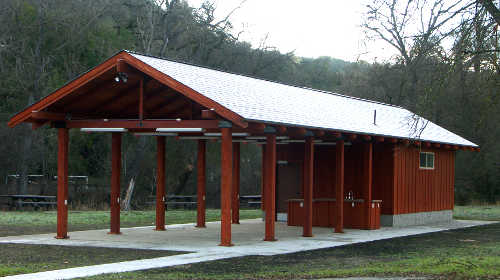
Daniel Wood of Middletown, Calif., was convicted of misdemeanor counts of indecent exposure and annoying or molesting a child on Wednesday, March 30, 2011. Lake County Jail photo.
CLEARLAKE, Calif. – On Wednesday a jury convicted a Middletown man of exposing himself to two young girls in 2010, a case that didn't come together until months after the incident when one of the victims spotted the suspect again.
Daniel Laine Wood, 29, was found guilty on misdemeanor counts of indecent exposure and annoying or molesting a child following a six-day trial before Lake County Superior Court Judge Stephen Hedstrom in Clearlake's Department 4, according to the Lake County District Attorney's Office.
“Even though it's a misdemeanor it's serious,” said Chief Deputy District Attorney Richard Hinchcliff.
In this case, Hinchcliff said the law didn't allow the District Attorney's Office to charge the crimes as felonies.
The case not only saw Lake County's new sheriff called to the stand to testify but also may end up in additional prosecutions for Wood, who is believed to be connected to still other cases involving crimes of a sexual nature.
Jurors deliberated 45 minutes Wednesday before returning the guilty verdicts, the District Attorney's Office said.
Wood is scheduled to return to court for sentencing on April 18. The District Attorney's Office said Judge Hedstrom referred the case to the Lake County Probation Department for a sentencing report and recommendation.
Deputy District Attorney Megan van Steenburgh, who prosecuted the case, said Wood faces a maximum of a year in jail, and will get credit for time he's served since his Dec. 29 arrest.
She said Wood also will be required to register as a sex offender for life based on the conviction.
Hedstrom ordered Wood held on $20,000 bail until his sentencing, officials said.
Wood's attorney, Jessica Schaps, declined comment for this story.
In an incident that took place last Aug. 28 in broad daylight on a Middletown street, Wood allegedly rode his bicycle up to two young girls – one age 12, one age 11 – pulled up his shorts and exposed his genitals, according to van Steenburgh.
Van Steenburgh said the girls alleged that Wood leered at them for several moments before fleeing the scene on his bicycle.
She said that, by the time sheriff's Deputy Kellie Joseph arrived on the scene, Wood could not be located, despite an area search conducted both by Joseph and the California Highway Patrol. Complicating the case was the fact that the girls didn't know Wood's identity.
However, last November one of the girls reportedly spotted Wood's bicycle at the Middletown Library on Nov. 18, Van Steenburgh said.
The girl later identified Wood in a photo lineup, van Steenburgh said. She and the second girl later would identify him in the courtroom as well.
A sheriff's office press release said sheriff’s deputies working the Middletown area and the Sheriff’s Major Crimes Unit – including Det. Mike Curran, who specializes in investigating such cases – worked to identify Wood, who was arrested in late December by Deputy Bill Djernes.
Hinchcliff said the case's original investigation had several problems with it. The District Attorney's Office did additional work to investigate the case, and he said van Steenburgh “worked really hard to get a conviction.”
Part of the difficulty, according to Hinchcliff, came from a report used in the case written by then-Deputy Frank Rivero, who has since been elected sheriff.
Van Steenburgh said Rivero didn't initially prepare a report himself. Hinchcliff said the District Attorney's Office asked Rivero to prepare a report several months later, which he did.
That report ended up being inconsistent with the statements given by the girl who spotted Wood's bicycle at the library, Hinchcliff said.
The girl is the granddaughter of one of Rivero's tenants, who lives behind him, Rivero said.
Rivero's report stated that the girl and her grandmother contacted him on Nov. 18 – while he was still on leave to conduct his campaign for sheriff – to say she had seen Wood at the library again.
That night, Rivero said he went to the library to look for the suspect. “By the time I got there the guy was gone,” he told Lake County News.
He said he asked the librarian about the suspect, and the librarian knew Wood and as able to give Rivero Wood's name, which Rivero said he then gave to Deputy Dennis Keithly. In addition, Rivero made phone calls and asked other deputies to take reports on the case.
Van Steenburgh said the inconsistencies arose in that the girl said she didn't actually see Wood on Nov. 18, but that she saw his bicycle, which didn't agree with Rivero's statements that she had actually spotted him.
On the stand the girl said she had seen Wood at the library once before, but saw his bicycle – not him – on Nov. 18, van Steenburgh said.
Hinchcliff said the inconsistencies led Schaps to call Rivero as a defense witness in order to impeach the girl's credibility.
Rivero said he already had been scheduled to testify as a prosecution witness. He called Schaps' attempt to use his testimony to discredit the girl “a shot in the dark,” and defended the sheriff's office's investigation, saying it was solid and helped lead to a conviction.
Van Steenburgh said the inconsistencies, ultimately, weren't enough to break the case.
On the stand the girls – who van Steenburgh said are both now 12 years old – “were very clear, they were very brave and in the end the jury believed them as they should have.”
In separate statements from the District Attorney's Office and Lake County Sheriff's Office, officials said Wood had been the subject of several previous contacts by the sheriff’s office involving alleged sexually deviant behavior, including an allegation that he possessed child pornography.
Sheriff's Capt. James Bauman said the child pornography case was reported to the sheriff's office in January of 2008 and sent to the District Attorney's Office that March, but didn't end up being filed.
Rivero said that case involved Wood downloading child pornography onto computers at Minnie Cannon Elementary School, where he worked at the time as a janitor. The sheriff alleged that Wood also was masturbating in the classrooms, and later was fired after that case was investigated.
The statute of limitations has already run out on that case, otherwise Rivero said he would have attempted to have to refiled.
Bauman said investigators also previously were contacted in 2006 about allegations involving Wood when he was a juvenile in 1999. Those cases also weren't filed criminally.
However, the most recent case involving Wood has led to inquiries into new allegations, Bauman said.
Following Wood's December arrest, Bauman said investigators were contacted about additional incidents.
“Because people have come forward subsequent to his December arrest on the indecent exposure case from Middletown, we have subsequently opened up three additional cases that are pending investigation,” Bauman said.
Rivero said Wood has been held in a special section of the jail so far, and that he would remain in that area, along with other sex offenders, as he's serving his sentence.
“If we put them in the general population they'd eat 'em alive,” he said.
E-mail Elizabeth Larson at This email address is being protected from spambots. You need JavaScript enabled to view it. . Follow Lake County News on Twitter at http://twitter.com/LakeCoNews , on Facebook at http://www.facebook.com/pages/Lake-County-News/143156775604?ref=mf and on YouTube at http://www.youtube.com/user/LakeCoNews .













